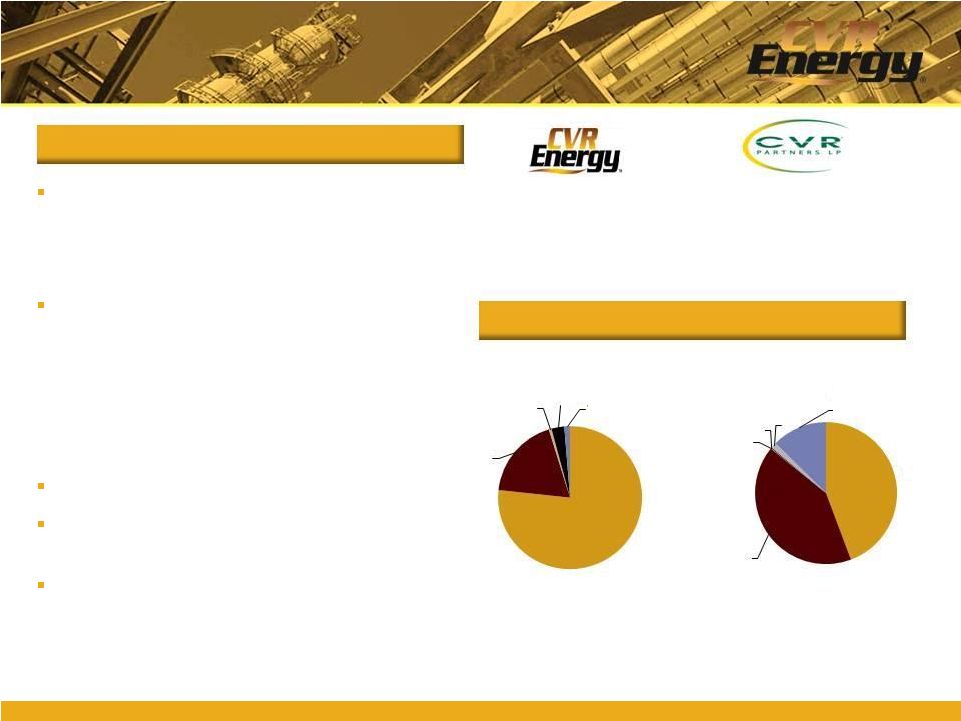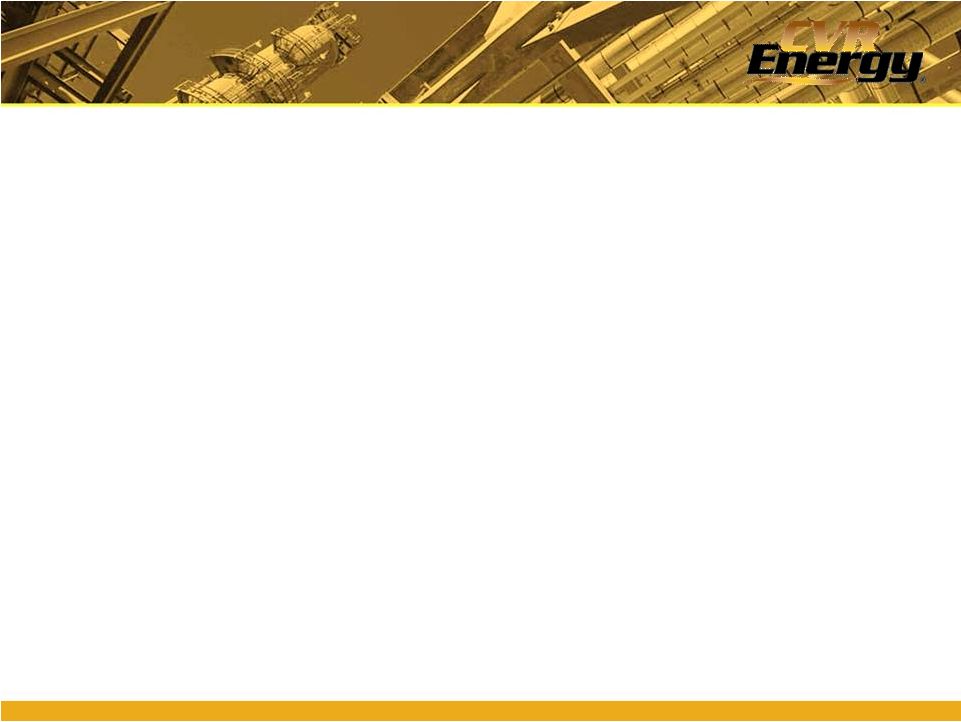Attached files
| file | filename |
|---|---|
| 8-K - FORM 8-K - CVR ENERGY INC | d323192d8k.htm |
 Investor Presentation
March 26, 2012
Exhibit 99.1 |
 1
1
1
1
1
Forward Looking Statements
The following information contains forward-looking statements based on management’s current
expectations and beliefs, as well as a number of assumptions concerning future events.
These statements are subject to risks, uncertainties, assumptions and other important
factors. You are cautioned not to put undue reliance on such forward-looking statements
(including forecasts and projections regarding our future performance) because actual results may
vary materially from those expressed or implied as a result of various factors, including, but
not limited to (i) those set forth under “Risk Factors” in CVR Energy, Inc.’s
Annual Report on Form 10-K, Quarterly Reports on Form 10-Q and any other filings CVR
Energy, Inc. makes with the Securities and Exchange Commission, and (ii) those set forth under
“Risk Factors” in the CVR Partners, LP Annual Report on form 10-K, Quarterly
Reports on Form 10-Q and any other filings CVR Partners, LP makes with the Securities
and Exchange Commission. CVR Energy, Inc. assumes no obligation to, and expressly disclaims
any obligation to, update or revise any forward-looking statements, whether as a result of
new information, future events or otherwise, except as required by law. |
 2
2
2
2
2
Management Attendees
Frank Pici
Chief Financial Officer
Ed Morgan
Executive Vice President of Investor Relations
Jay Finks
Director of Finance |
 Company Overview |
 Pro
Forma Company Overview Two top-tier Mid-Continent refineries
–
115,000 bpd Coffeyville, Kansas refinery
–
70,000 bpd Wynnewood, Oklahoma
Refinery
A nitrogen fertilizer plant using pet coke
gasification (CVR Partners LP)
–
Rated capacity of 1,225 tpd ammonia;
2,025 tpd UAN Nitrogen
–
Current $100.0 million expansion
ongoing to increase UAN capacity by
400,000 tons
Operates in higher margin markets
Logistics assets supporting both
businesses
Financial flexibility
LTM Refinery Feedstock & Product Slate
CVR Energy: About Us
Note: LTM as of December 31, 2011. Includes only 16 days of Wynnewood
(a)
CVR distillate assumed to be diesel.
NYSE–
CVI
Market Cap
(1)
-
$2.3 billion
NYSE–
UAN
Market Cap
(1)
-
$1.8 billion
CVI owns ~ 70%
(1) As of 3/16/2012
4
4
4
4
Sweet Crude
77%
Sour Crude
18%
Butane
1%
Isobutane
3%
Other feedstocks
1%
Gasoline
44%
Jet Fuel
0%
Asphalt
0%
LPG
1%
Other
13%
Diesel
36%
(a) |
 5
5
5
5
5
Company
Total
Capacity
(Kbpd)
Blended
Complexity
Marathon Petroleum
602.0
10.0
ConocoPhilliips
(a)
560.4
9.1
BP
(b)
470.7
9.6
HollyFrontier
293.3
13.0
Valero Energy
265.0
8.9
Koch Industries
262.0
9.8
ExxonMobil
238.6
10.6
Husky Energy
(b)
220.7
9.7
CVR Energy / Wynnewood
185.0
11.5
CITGO Petroleum
167.0
9.8
PBF Energy
160.0
9.2
National Cooperative Refinery Association
85.5
15.8
Northern Tier Energy
74.0
10.5
Tesoro
58.0
7.8
Calumet
Specialty Products
45.0
8.9
CountryMark Cooperative
26.5
9.7
Somerset Refinery
5.5
3.3
Total PADD II Refining Capacity
3,719.2
PADD
II
Consolidated
Refinery
Statistics
–
By
Owner
“Top Quartile”
Consolidated Asset Profile
PADD II Refiners
Median
Capacity:
185.0
Median
Complexity
9.7
NCRA
CMC
SR
Capacity: 185 kbpd (Coffeyville & Wynnewood)
Complexity: 11.5 (blended average)
0.0
2.0
4.0
6.0
8.0
10.0
12.0
14.0
16.0
0
50
100
150
200
250
300
350
400
450
500
550
600
650
700
Crude Unit Processing Capacity (000's bpd)
Well Positioned to Compete in
Underserved PADD II Region
Source: EIA and Wall Street research
(a) 100% of capacity in Wood River, IL refinery JV consolidated (50%
ownership interest). (b) Includes 50% interest in JV in Toledo, OH refinery. |
 6
6
6
6
6
Key Business Drivers
(1) Adjusted for major scheduled turnaround, third-party outage on air
separation unit and UAN vessel rupture Source: S&P Capital IQ
($40)
($35)
($30)
($25)
($20)
($15)
($10)
($5)
$0
Mar-10
May-10
Jul-10
Sep-10
Nov-10
Jan-11
Mar-11
May-11
Jul-11
Sep-11
Nov-11
Jan-12
Mar-12
WCS -
WTI Differential
($35)
($30)
($25)
($20)
($15)
($10)
($5)
$0
$5
$10
May-10
Jul-10
Oct-10
Jan-11
Apr-11
Jun-11
Sep-11
Dec-11
Mar-12
WTI vs. Midale & WTS
Midale-WTI Differential
WTS-WTI Differential
70%
75%
80%
85%
90%
95%
100%
105%
70%
75%
80%
85%
90%
95%
100%
2008
2009
2010
2011
Refining & Fertilizer
(1)
Utilization
Gasifier
Ammonia
UAN
Refining Utilization |
 7
7
7
7
7
Source: EIA
Utilization by PADD
Source: Magellan
88.7
86.1
82.1
84.8
83.5
60
65
70
75
80
85
90
95
100
2007
2008
2009
2010
2011
PADD 1
PADD II
PADD III
PADD IV
PADD V
Average
Magellan Pipeline Inventories over 4 Year Range
Gasoline
Magellan Pipeline Inventories over 4 Year Range
ULS Diesel |
 8
8
8
8
8
CVR Energy total shareholder return
Source: Capital IQ
20
40
60
80
100
120
140
160
CVI
Refining Peers Index
S&P 500
CVI
Refining peers
S&P 500
Since IPO
459%
81%
80%
2-
198%
134%
20%
1-year
39%
13%
10%
year
year
3
-
32%
(39%)
(10%)
Note:
Market data as of March 16, 2012. Peer index equal weighted and includes ALJ, DK, HFC, TSO and
WNR. CVI IPO price is based on closing price of the first day of trading.
Refiners relative total return performance
0
Oct -07
Feb -08
Jun -08
Oct -08
Feb -09
Jun -09
Oct -09
Feb -10
Jun -10
Oct -10
Feb -11
Jun -11
Oct -11
Feb -12 |
 9
9
9
9
9
Building the business
Responsive to opportunities
Improving financial strength
Shareholder Value Focused
Increased total refining capacity to 185 kbpd
Integrating Wynnewood acquisition and
realizing synergies
Grown crude gathering to ~40,000 bpd
Expanding UAN capacity by 400,000 tpy
IPO of CVR Partners
Accretive acquisition of GWEC
Initiating regular quarterly dividend $0.08/sh
Planned secondary offering of CVR Partners
units, with the after-tax proceeds primarily
used to pay a special dividend
Continuously evaluating alternatives to
realize
CVR
Partners’
value
Conservative leverage metrics
Tactical hedging for risk management
Ratings improvement to Ba3
Focus on maintaining discipline
Since IPO, CVR Energy is #1 in total
return among refining peers
(a)
and
remains focused on creating value for
shareholders
(a) Total return based on period from October 23, 2007 to March 16, 2012. CVI total return
compared to total return of refining peers: ALJ, DK, HFC, TSO and WNR. |
 Refining Business |
 11
11
11
11
11
Consolidated Supply Network
Consolidated Marketing Network
Extensive Crude Oil Supply and
Product Distribution Network
Major Canadian Crude Oil Pipelines
Terminals
Third-Party Refined Product Pipelines
Wynnewood Refinery
Coffeyville Resources Refining &
Marketing and Nitrogen Fertilizer
Wynnewood Exchange Terminals
CVR Crude Oil Pipelines
Third-Party Crude Oil Pipelines
Wynnewood Related Pipelines
CVR Headquarters |
 12
12
12
12
12
Logistics Overview
Operations Map
Logistics Drives Profitability
(a)
Under construction.
Located 100 miles from the global crude hub of
Cushing, CVR has access to global crudes with
storage to optimize purchasing and crude slates
Shipper status of 35,000 bpd on Spearhead and
Keystone Pipelines
40,000+ bpd crude oil gathering system serving
Kansas, Oklahoma, Texas, Missouri and
Nebraska
145,000 bpd proprietary pipeline system to
transport crude to the Coffeyville refinery
Coffeyville Resources
Refining & Marketing and Nitrogen
Fertilizer
Coffeyville Resources Refined Fuel
Products / Asphalt Terminal
Wynnewood Refinery
Coffeyville Resources Crude
Transportation
Offshore Deepwater Crude
Foreign Crude
Coffeyville Resources Crude Oil
Pipeline
Third-Party Crude Oil Pipeline
CVR Energy Headquarters
Legend
Total 6.1 mm bbls
Crude Storage Owned / Leased
Canada |
 13
13
13
13
13
Overview
Historical & Projected Canadian Production
(a)
Historical & Projected Bakken Crude Production
(b)
Access to WTI Priced Crudes
(a)
Source: Canadian Association of Petroleum Producers June 2011 publication.
(b)
Source: Wood Mackenzie Upstream Service database
Both refineries benefit from the current WTI-Brent spread
WTI price-linked crudes are currently trading at
historically wide discounts to crudes, such as Brent
and
LLS
Growing production from the U.S. Bakken and Canada
flowing into Cushing, OK is contributing to this
differential
Expected pipeline capacity (Seaway reversal) necessary
to move production from Cushing to the Gulf Coast
projected to move 250k bpd heavy/sour by 2013
87.6
102.1
132.7
142.3
201.8
262.9
313.1
340.0
362.4
0
100
200
300
400
2006
2007
2008
2009
2010
2011
2012
2013
2014
Bakken Crude Production
(thousand barrels per day)
Historical WTI-Brent Spread ($/bbl)
2007
2009
2011
2013
2015
2017
2019
2021
2023
2025
Other
Conventional
Oil Sands
Atlantic Canada Offshore
0
1,000
2,000
3,000
4,000
5,000
2005
(thousand barrels per day)
Actual
Forecast
$0
$20
$40
$60
$80
$100
$120
$140
Mar-10
Jun-10
Sep-10
Dec-10
Mar-11
Jun-11
Sep-11
Dec-11
Mar-12
Brent-WTI Differential
WTI
Brent
($5.00)
$0.00
$5.00
$10.00
$15.00
$20.00
$25.00
$30.00 |
 14
14
14
14
14
Hedging Activity
2.9
4.8
4.7
3.1
2.0
1.1
1.1
1.1
$23.87
$26.12
$23.68
$20.54
$24.23
$24.74
$23.67
$22.23
$0
$5
$10
$15
$20
$25
$30
0.0
1.0
2.0
3.0
4.0
5.0
6.0
Q1 '12
Q2 '12
Q3 '12
Q4 '12
Q1 '13
Q2 '13
Q3 '13
Q4 '13
Volume Hedged
Base Level 11/28/2011
As of 12/31/2011
As of 1/31/2012
As of 3/15/2012
Hedged Crack Spread
$17.88
$16.73
$22.77
$26.51
$0
$5
$10
$15
$20
$25
$30
2012
NYMEX 2-1-1
11/28/11
12/31/11
01/31/12
3/15/2012
-$7
-$6
-$5
-$4
-$3
-$2
-$1
$0
$1
$2
$3
Jul '11
Aug '11
Sep '11
Oct '11
Nov '11
Dec '11
Jan '12
Feb '12
Mar '12
Group 3 Product Basis |
 Overview
Asset Map
Total Consumed Crude Discount to WTI
Crude Gathering
Gathered 7,000 bpd in 2005
Today gathering over 40,000+ bpd
Growth
target
10%
–
20%
per
year
for
the
next 2 –
5 years
Texas
Oklahoma
Missouri
Nebraska
Kansas
Colorado
South Dakota
North Dakota
4 year average is $3.53
Barrels Gathered Per Day
15,000+
Up to 10,000
Up to 1,000
Refining Operations
Corporate
Headquarters
Growth Prospects
($7)
($6)
($5)
($4)
($3)
($2)
($1)
$0
$1
$2
15
15
15
15
15 |
 16
16
16
16
16
Phillipsburg
Valley Center
Station
Winfield
(Gathering South)
Plainville
(Gathering North)
Hooser
Station
Broome
Station
Humboldt
(Gathering South)
Coffeyville
East Tank Farm
Cushing
Plains/TEPPCO
Barnsdall
(Gathering South)
Shidler
(Gathering South)
55k
3,000k
Capacity 17,900 bpd w/DRA
Capacity 4,800 bpd
Capacity 24,000 bpd w/DRA
Capacity 110,000 bpd
Capacity 30,000 bpd
Capacity 4,700 bpd
Capacity 38,000 bpd
660k
160k
200k
10k
40k
20k
Jayhawk/Kaw
Pipeline system
150 miles
67 miles
23 miles
100 miles
Plains Pipeline
25 miles
19 miles
42 miles
1.6 miles
62.5 miles
Capacity 107,000 bpd
18 miles
156,000 b/d
Crude Gathering System
“No Barrel Left Behind”
Gathered
Blended
Refined
Osage Station
Owned
1,000k
30k
Fairfax
25 miles
Capacity 30,000 bpd |
 Nitrogen Fertilizer MLP |
 18
18
18
18
18
Overview
Fertilizer Operations
Strategically Located Assets and Logistics
Located in the corn belt
(on Union Pacific
mainline)
45% of corn planted in
2010 was within $35/UAN
ton freight rate of our plant
$25/ton transportation
advantage to corn belt vs.
US Gulf
Coast
No intermediate transfer,
storage, barge freight or
pipeline freight charges
Additional
Shipments
East of the
Mississippi
Rail Distribution
2011 Tons Sold by State
100,000+
10,000 to 100,000
Up to 10,000
Corporate
Headquarters
Fertilizer Plant
2011 Total Tons Sold ~ 822,000 |
 19
19
19
19
19
Overview
Abundant Supply of Third-party Pet Coke
US Pet Coke Exports and Consumption
Stable & Economic Feedstock
Source: EIA
CVR Partners LP 2008 –
2010 average daily coke demand ~ 1,378
tons/day
Coke gasification technology uses petroleum coke as a feedstock
–
Pet coke costs lower than natural gas costs per ton of ammonia
produced, and pet coke prices are significantly more stable than
natural gas prices
–
Over 70% of pet coke supplied by refinery through long-term
contract
Dual train gasifier configuration ensures reliability
Ammonia synthesis loop and UAN synthesis use same processes as
natural gas based producers
Texas Gulf Coast Coke
Production = 40,000
tons/day
Source: Oil & Gas Journal
Rail Distribution
Corporate
Headquarters
Fertilizer Plant |
 20
20
20
20
20
Market Fundamentals
Farmer Profitability Supports Fertilizer Pricing
Corn consumes the largest amount of nitrogen fertilizer
Farmers are expected to generate substantial proceeds at currently forecasted corn
prices Farmers are still incentivized to apply nitrogen fertilizer at corn
prices lower than current spot Nitrogen fertilizer represents a small
percentage of a farmer’s input costs Corn Spot Prices
Breakdown of U.S. Farmer Total Input Costs
Input Costs and Prices per Bushel ($)
Other Variable Costs 13%
Seed and Chemicals 18%
Fixed Costs 48%
Avg. % Total of Cost:
Corn Futures Prices*:
30 Day: $6.63
12 Month: $5.80
Note: Fixed Costs include labor, machinery, land, taxes, insurance, and other.
Fertilizers 21%
Current
$6.73*
*As of Mar. 16, 2012
Source: CIQ
*As of Mar. 16, 2012
Source:
CIQ,
USDA |
 21
21
21
21
21
Market Fundamentals
Strong Pricing Environment
($ per Ton)
Historical U.S. Nitrogen Fertilizer Prices
Ammonia
$651
UAN
$400
Southern Plains
Ammonia
Corn Belt UAN
5-Yr Average Southern
Plains Ammonia
Source:
Green Markets Data, Fertecon
5 Yr. Avg.
UAN $168
5-Yr Average
Corn Belt UAN
5 Yr. Avg.
Ammonia $294
5 Yr. Avg.
Ammonia $497
5 Yr. Avg.
UAN $315
0
100
200
300
400
500
600
700
800
900
1,000
1999
2000
2001
2002
2004
2005
2006
2007
2009
2010
2011
Robust global grain demand coupled with
capacity reductions has lead to significant
nitrogen fertilizer price increases
5 year average UAN price has increased
88% over previous 5 year average
UAN commands a premium over ammonia
and urea on a nutrient basis |
 Financial Highlights |
 23
23
23
23
23
EBITDA by Operating Segment ($mm)
Capital Expenditures ($mm)
(a)
Refining Margins and Expenses ($/bbl)
Fertilizer Prices ($/Ton)
Key Historical Financial Statistics
CVR Energy Standalone
(a) Total capital expenditures of $278.3mm for 2012,
consisting of $164.6mm for petroleum, $109.8mm for Fertilizer and $3.9mm for corporate
(b) Direct opex per barrel excludes turnaround.
Note: Adjusted Petroleum EBITDA represents petroleum operating income adjusted for FIFO
impacts, share-based compensation, loss on disposal of fixed assets, major scheduled
turnaround expenses, realized gain and losses on derivatives, net, depreciation and amortization and other income or expenses. Adjusted Fertilizer
EBITDA represents nitrogen fertilizer operating income adjusted for share-based compensation, loss
of disposal of fixed assets, major scheduled turnaround expenses, depreciation and amortization
and other income or expenses. $109
$142
$155
$581
$130
$71
$53
$163
2008
2009
2010
2011
Adjusted Petroleum EBITDA
Adjusted Fertilizer EBITDA
$60
$34
$20
$69
$24
$13
$10
$19
$2
$2
$3
$4
2008
2009
2010
2011
Petroleum Capex
Fertilizer Capex
Corporate
$328
$223
$202
$312
$596
$342
$382
$596
2008
2009
2010
2011
UAN price
Ammonia price
$11.04
$8.91
$8.07
$21.12
$3.91
$3.58
$3.67
$4.79
2008
2009
2010
2011
Adjusted refining margin per barrel
Direct
opex
(before
D&A)
per
barrel
(b) |
 24
24
24
24
24
CVI Operating Expenses
(a)(b)
($/bbl)
2011 Operating Expense
(b)
($/bbl)
Controlled Operating Expenses
(a)
Excludes turnaround. Includes only 16 days of Wynnewood operation.
(b)
Calculated on a per barrel of crude throughput.
(a) |
 Appendix |
 26
26
26
26
26
Organizational Structure
CVR Energy, Inc.
NYSE: CVI
Coffeyville Resources, LLC
Fertilizer business
CVR Partners, LP
NYSE: UAN
Refining business
Public shareholders
Public unitholders
100%
100%
100% GP
69.7% LP
30.3% LP
Wynnewood Refinery (GWEC)
(Wynnewood, OK)
Coffeyville Refinery
(Coffeyville, KS)
100%
100%
$400m ABL due ’15
$447m
9%
1
st
Lien
notes
due
‘15
$223m
10
7/8
%
2
nd
Lien
notes
due
‘17
$25m cash flow revolver due ’16
$125m term loan due ‘16 |
 27
27
27
27
27
Non-GAAP Financial Measures
To supplement the actual results in accordance with U.S. generally accepted
accounting principles (GAAP), for the applicable periods, the Company also uses
certain non-GAAP financial measures as discussed below, which are
adjusted for GAAP-based results. The use of non-GAAP adjustments are
not in accordance with or an alternative for GAAP. The adjustments are
provided to enhance the overall understanding of the Company’s financial
performance for the applicable periods and are also indicators that management
utilizes for planning and forecasting future periods. The non-GAAP
measures utilized by the Company are not necessarily comparable to similarly
titled measures of other companies. The Company believes that the
presentation of non-GAAP financial measures provides useful information to
investors regarding the Company’s financial condition
and
results
of
operations
because
these
measures,
when
used
in
conjunction with related GAAP financial measures (i) together provide a more
comprehensive view of the Company’s core operations and ability to generate cash
flow, (ii) provide investors with the financial analytical framework upon
which management bases financial and operational planning decisions, and (iii)
presents measurements that investors and rating agencies have indicated to
management are useful to them in assessing the Company and its results of
operations. |
 28
28
28
28
28
Non-GAAP Financial Measures (cont’d)
EBITDA represents net income before the effect of interest expense, interest income, income
tax expense (benefit) and depreciation and amortization. EBITDA is not a calculation based
upon GAAP; however, the amounts included in EBITDA are derived from amounts included in the
consolidated statement of operations of the Company. Adjusted EBITDA by operating segment
results from operating income by segment adjusted for items that the company believes are needed
in order to evaluate results in a more comparative analysis from period to period.
Additional adjustments to EBITDA include major scheduled turnaround expense, the impact of the
Company’s use of accounting for its inventory under first-in, first-out (FIFO), net
unrealized gains/losses on derivative activities, share-based compensation expense, loss on
extinguishment of debt, and other income (expense). Adjusted EBITDA is not a recognized
term under GAAP and should not be substituted for operating income or net income as a measure of
performance but should be utilized as a supplemental measure of financial performance in
evaluating our business.
EBITDA:
The Company’s basis for determining inventory value on a GAAP basis.
Changes in crude oil prices can cause fluctuations in the inventory valuation of our crude oil,
work in process and finished goods, thereby resulting in favorable FIFO impacts when crude oil
prices increase and unfavorable FIFO impacts when crude oil prices decrease. The FIFO impact
is calculated based upon inventory values at the beginning of the accounting period and at the
end of the accounting period.
First-in, first-out (FIFO): |
 29
29
29
29
29
Non-GAAP Financial Measures (cont’d)
CVR Adjusted EBITDA ($mm)
2008
2009
2010
2011
Petroleum operating income
$31.9
$170.2
$104.6
$465.7
FIFO impact (favorable) unfavorable
102.5
(67.9)
(31.7)
(25.6)
Share-based compensation
(10.8)
(3.7)
11.5
8.7
Loss on disposal of fixed assets
-
-
1.3
2.5
Major scheduled turnaround
-
-
1.2
66.4
Realized gain (loss) on derivatives, net
(121.0)
(21.0)
0.7
(7.2)
Goodwill impairment
42.8
-
-
-
Depreciation and amortization
62.7
64.4
66.4
69.9
Other income (expense)
1.0
0.3
0.7
0.5
$109.1
$142.3
$154.7
$580.9
2008
2009
2010
2011
Fertilizer operating income
$116.8
$48.9
$20.4
$136.2
Share-based compensation
(10.6)
3.2
9.0
7.3
Loss on disposal of fixed assets
2.3
-
1.4
-
Major scheduled turnaround
3.3
-
3.5
-
Depreciation and amortization
18.0
18.7
18.5
18.9
Other income (expense)
0.1
-
(0.2)
0.2
$129.9
$70.8
$52.6
$162.6
Adjusted EBITDA
Adjusted EBITDA
Petroleum:
Fertilizer: |
